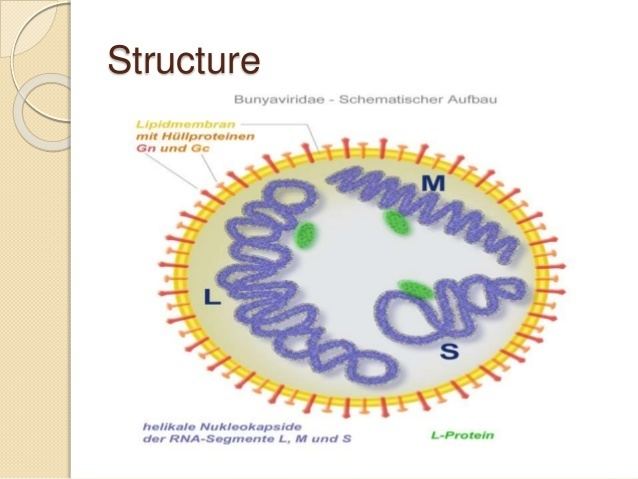Group Group V ((-)ssRNA) Scientific name Bunyaviridae | Order Unassigned Rank Family | |
 | ||
Lower classifications Tomato spotted wilt virus, Schmallenberg virus, Akabane virus, Hantavirus, California encephalitis virus Similar Emaravirus , Arenavirus , Bhanja virus | ||
Medical vocabulary what does bunyaviridae infections mean
Bunyaviridae is a family of virus belonging to the fifth group of the Baltimore classification, the so called negative-sense single stranded ribonucleic acid (-)ssRNA. They are enveloped RNA viruses. Though generally found in arthropods or rodents, certain viruses in this family occasionally infect humans. Some of them also infect plants.
Contents
- Medical vocabulary what does bunyaviridae infections mean
- Classification
- Structure
- Genome
- Replication
- Diseases in Humans
- References
Bunyaviridae are vector-borne viruses. With the exception of Hantaviruses, all viruses in the Bunyaviridae family are transmitted by arthropods (mosquitos, tick, or sandfly). Hantaviruses are transmitted through contact with deer mice feces. Incidence of infection is closely linked to vector activity, for example, mosquito-borne viruses are more common in the summer.
Human infections with certain Bunyaviridae, such as Crimean-Congo hemorrhagic fever virus, are associated with high levels of morbidity and mortality, consequently handling of these viruses must occur with a Biosafety level 4 laboratory. They are also the cause of severe fever with thrombocytopenia syndrome.
Hanta virus or Hantavirus Hemorrhagic fever, common in Korea, Scandinavia, Russia, and western North America, is associated with high fever, lung edema and pulmonary failure. Mortality is around 55%.
The antibody reaction plays an important role in decreasing levels of viremia.
Classification
There are currently about 330 viruses recognised in this family.
The family Bunyaviridae contains the genera:
There are a number of viruses that have not yet been placed in a genus: these include Gan Gan virus, Maprik virus, Mapputta virus and Trubanaman virus.
A new genus - as yet unnamed - has been proposed based on isolates from phantom midges.
Two additional viruses may lie outside the previously defined taxa: Ferak virus (FERV) and Jonchet virus (JONV).
Structure
Bunyavirus morphology is somewhat similar to that of the Paramyxoviridae family; Bunyaviridae form enveloped, spherical virions with diameters of 90–100 nm. These viruses contain no matrix proteins.
Genome
Bunyaviridae have tripartite genomes consisting of a large (L), medium (M), and small (S) RNA segment. These RNA segments are single-stranded, and exist in a helical formation within the virion. Besides, they exhibit a pseudo-circular structure due to each segment's complementary ends. The L segment encodes the RNA Dependent RNA-polymerase, necessary for viral RNA replication and mRNA synthesis. The M segment encodes the viral glycoproteins, which project from the viral surface and aid the virus in attaching to and entering the host cell. The S segment encodes the nucleocapsid protein (N).
The L and M segment are negative sense. For the Genera of Phlebovirus and Tospovirus, the S segment is ambisense. Ambisense means that some of the genes on the RNA strand are negative sense and others are positive sense. The S segment codes for the viral nucleoprotein (N) in the negative sense and a nonstructural (NSs) protein in ambisense.
Total genome size ranges from 10.5 to 22.7 kbp.
Replication
This ambisense arrangement requires two rounds of transcription to be carried out. First the negative sense RNA is transcribed to produce mRNA and a full length replicative intermediate. From this intermediate a subgenomic mRNA encoding the small segment nonstructural protein is produced while the polymerase produced following the first round of transcription can now replicate the full length RNA to produce viral genomes.
Bunyavirus RNA replicates in the cytoplasm, while the viral proteins transit through the ER and Golgi apparatus. Mature virions bud from the Golgi apparatus into vesicles which are transported to the cell surface.
Diseases in Humans
Bunyaviruses that cause disease in humans include:
Bunyaviruses have segmented genomes, making them capable of rapid recombination and increasing the risk of outbreak. Bunyaviridae are transmitted by hematophagous arthropods including mosquitoes, midges, flies, and ticks. The viral incubation period is about 48 hours. Symptomatic infection typically causes nonspecific flulike symptoms with fever lasting for about three days. Because of their nonspecific symptoms, Bunyavirus infections are frequently mistaken for other illnesses. For example, Bwamba fever is often mistaken for malaria.
